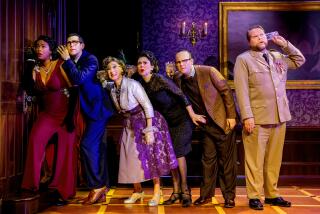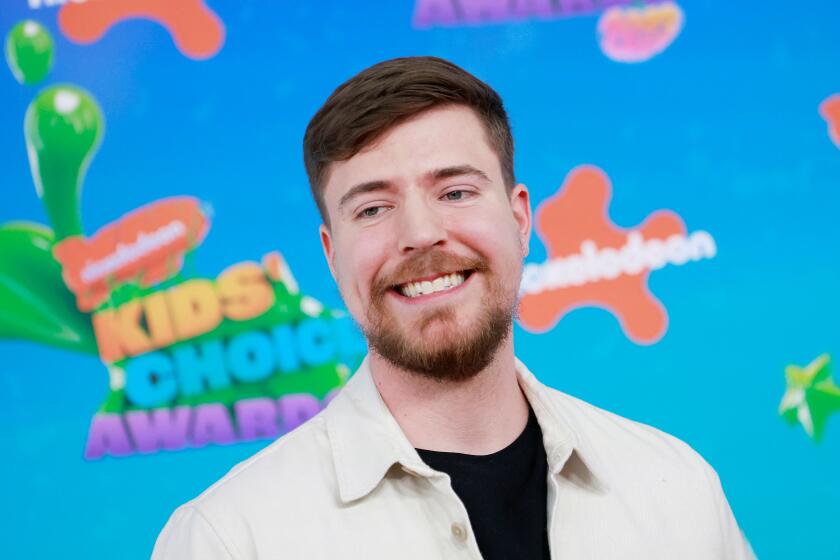Review: ‘Valentine Road’ offers clear-eyed view of Larry King murder
When children kill children, the cry of social anguish almost always ends with “Why?” Even when we actually know the answers.
When a child wins a gold medal or plays Carnegie Hall, we look to the people who supported that journey. But when one child kills another, society takes several steps back. How did this happen, we wonder, wringing our hands as the headlines decrease in point size, and then we all move on.
Marta Cunningham’s documentary “Valentine Road” is a profoundly disturbing and extremely effective attempt to make us stop in our tracks and try to answer the questions we so patly ask.
PHOTOS: Families that changed TV
On Feb. 12, 2008, while in the computer lab of E.O. Green Junior High School in Oxnard, 14-year old Brandon McInerney took a gun from his sweat shirt pocket and shot his 15-year-old classmate Larry King in the back of the head. Larry died two days later.
In this case, the “why” seemed horrifying simple. Larry had recently become more open about his sexuality and gender identity; he had begun wearing makeup and women’s high heels to school. Cross-dressing was not common at Green, nor were openly gay students.
Larry, small for his age, multiracial and increasingly flirtatious with other boys, was already a target for teasing. As Valentine’s Day neared, Larry approached Brandon as he played basketball with his friends and asked Brandon to be his valentine. Brandon shot him the next day.
Larry’s murder became a rallying point for the LGBT community. It also exposed the often lethally mixed feelings this country still has about homosexuality and gender ambiguity, especially among teenagers. As “Valentine Road” quickly makes clear, the staff and administration at E.O. Green literally did not know what to do with Larry.
Many of his teachers believed he should have been discouraged from cross-dressing. They feared, they say in the film, that something like this would happen.
Yet according to friends interviewed in the film, Larry was as happy as he had ever been. Having been removed from an adoptive father he claimed was physically abusive, he was living in Casa Pacifica, a group home and treatment center. (His father denied the charges and is not part of this film.) The support he received at Casa Pacifica, and from new foster parents, allowed him to explore the gender issues he had struggled with for so long.
The same could not be said of Brandon, whose early life had been just as traumatic as Larry’s, the film makes clear. His mother was a drug addict, his father prone to violence, often including guns. His two older stepbrothers were in and out of trouble with the law; the eldest was friendly with a local white supremacist to whom he introduced Brandon. At the time of the shooting, Brandon was living with his father and grandfather, while his mother, previously homeless, was in rehab, unable to take her son even though she says he begged her to do so.
None of which excuses Brandon’s actions, nor does this documentary suggest it should. Deftly assembling interviews with friends and family of both boys, as well as teachers, students, both the prosecuting and defending lawyers as well as jury members, Cunningham creates an exceptionally clear-eyed portrait of the crime.
FULL COVERAGE: Fall TV preview 2013
The film’s second half deals with the trial. Delayed for more than three years, it ended in mistrial. The jury split over whether the crime was voluntary manslaughter or first- or second-degree murder. (McInerney later pleaded guilty to second-degree murder and voluntary manslaughter and was sentenced to 21 years in prison.)
Interviews with some jury members reveal that many were unwilling to give a life sentence to a teenager. More alarming was the feeling shared by some that Larry had contributed to his death by sexually harassing Brandon while the school did nothing. “[Brandon] was just solving a problem,” one juror said.
“Valentine Road” clearly comes down on the side of Larry and all teens whose gender identities and/or sexuality make them targets. But Cunningham does not demonize Brandon. She does not romanticize him either.
PHOTOS: Dysfunctional TV famalies
Instead, she presents him as what he was: a child formed by certain forces, including those that, subtly and not so subtly, define sexual diversity as not just deviance from the mainstream, but an attack against it.
It is not a happy film, “Valentine Road.” One narrative thread follows a friend of Larry’s as she comes out and begins to dress as she feels comfortable. The sight of her walking along the beach with her girlfriend is as hopeful as things get.
But it’s an important film, especially now when the legalization of gay marriage in a few states and the appearance of gay characters on television can make it seem that being gay, lesbian, bisexual or transgender is no longer an issue. “Valentine Road” reminds us how very big an issue it still is.
----------------------------------------
‘Valentine Road’
Where: HBO
When: 9 p.m. Monday
Rating: TV-14 (may be unsuitable for children under the age of 14)
More to Read
The complete guide to home viewing
Get Screen Gab for everything about the TV shows and streaming movies everyone’s talking about.
You may occasionally receive promotional content from the Los Angeles Times.







